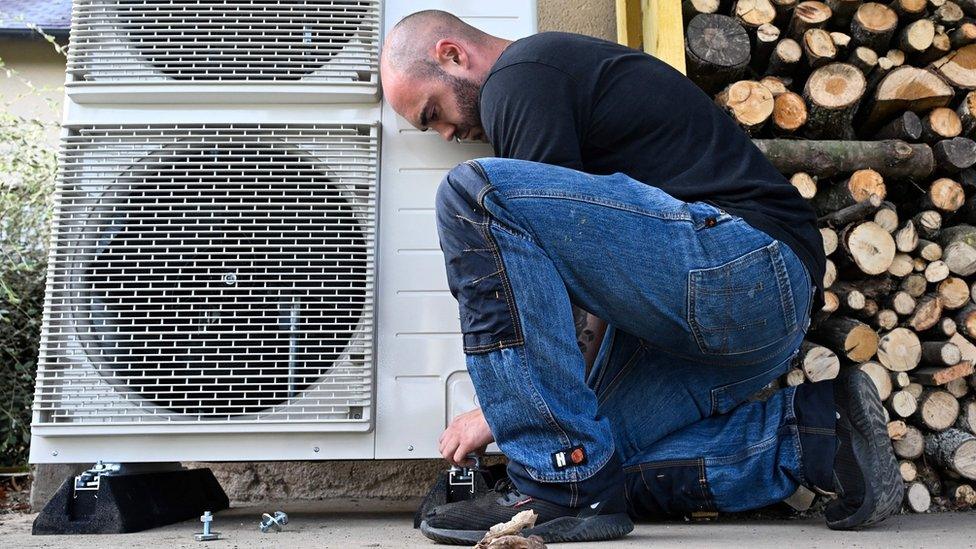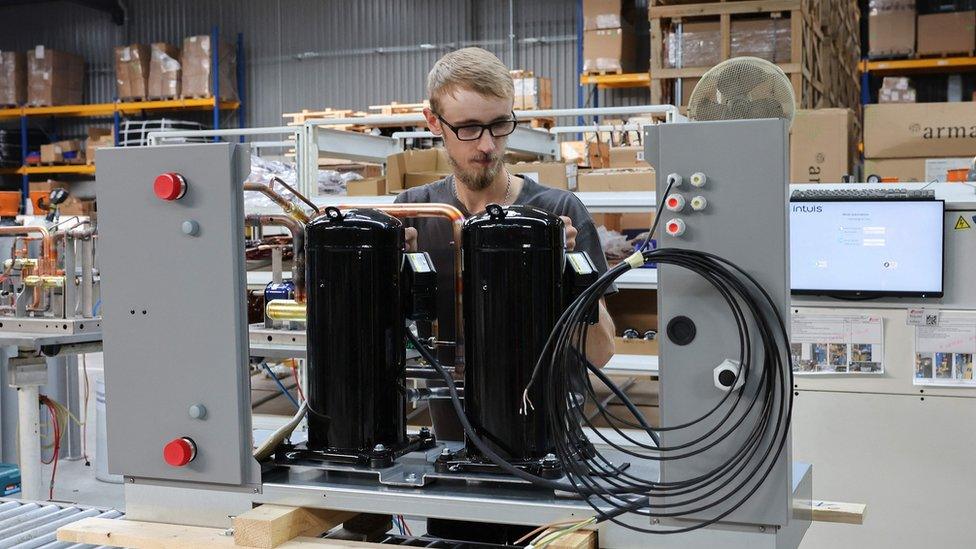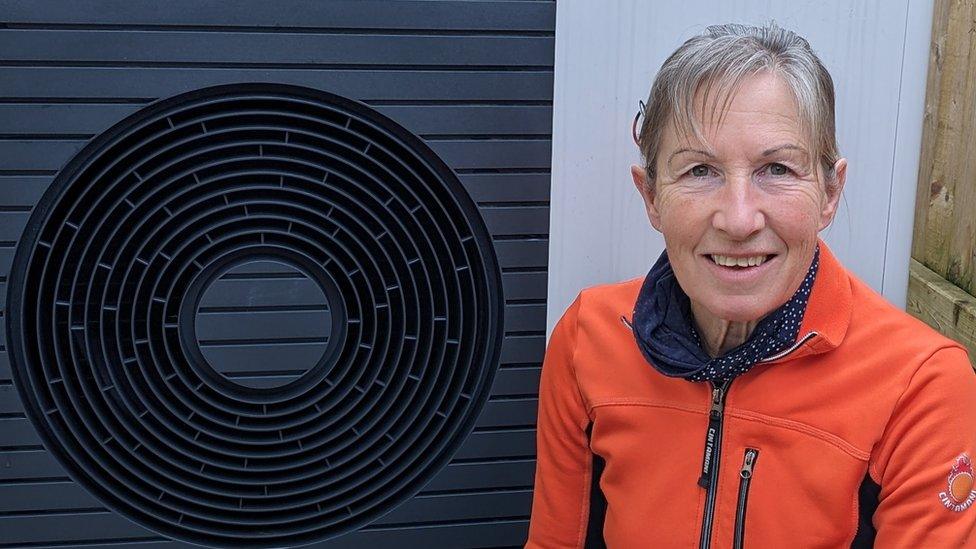Will hotter heat pumps win over homeowners?
- Published

Newer heat pumps can supply water at much hotter temperatures
The first heat pumps Graham Hendra sold, about 15 years ago, weren't very hot.
"To get 50C - that was quite hard," says the former wholesaler, referring to the temperature of the water that these devices sent to radiators, known as the flow temperature.
Today's gas combi boilers are typically designed for flow temperatures of around 50-60C.
The older heat pumps might have struggled to heat some homes adequately unless the homeowner decided to install larger radiators, for example. The increased surface area of such radiators helps transfer heat into the room.
But a new breed of heat pumps is emerging. Engineers have gradually improved the technology, meaning that heat pumps are now able to supply much higher temperatures, sometimes in excess of 70C.
A major change has been the rise of new refrigerants, including R290, or propane. This is the fluid that circulates inside a heat pump. In an air source device, the refrigerant captures warmth from the outside air, even on cold days. By compressing the slightly warmed refrigerant, the heat pump is able to increase the temperature and then transfer that heat into a property.
R290 is more environmentally friendly than older refrigerants so leaks are not as potentially damaging in climate change terms. Plus, it is up to 34% more efficient, external, which helps heat pumps supply higher temperatures without incurring severe efficiency losses.
Mr Hendra is now technical director at Genous, a firm that gives advice to homeowners on how to make their properties more energy efficient.
"We have a thing in our industry that I call 'temperature anxiety'," he says, likening it to the "range anxiety" that some consumers have about electric cars.

The newest heat pumps contain different refrigerants - the fluids which extract heat from the air
But the advent of hotter heat pumps means that such concerns are increasingly becoming irrelevant, he suggests.
It might take time to convince some, however. Paul Ciniglio, head of whole home retrofit at National Energy Foundation, a charity, is currently working on a project in Bicester covering more than 500 homes.
"We're trying to get as many as a quarter of them to sign up to heat pumps but it's proving really hard going," he says. "There has been so much negative press."
Some residents are sceptical the heat pumps will be hot enough, he explains, adding, "With the advent of this new refrigerant, it could be a game-changer."
Among the firms offering R290-based heat pumps are Octopus Energy, a renewable energy company. It recently announced a heat pump called Cosy 6, which can heat water up to a maximum of 80C. In principle, homeowners could change their heating system over with little fuss, says Alex Schoch, head of flexibility. "Combi boiler out, heat pump in," as he puts it. This could make heat pumps viable in a broader range of UK homes, which are notoriously poorly insulated, external in comparison with much of Europe.
Vaillant's aroTHERM plus heat pump works in outdoor temperatures as low as -20C and can supply hot water at up to 75C, though to remain efficient it is best not to exceed 55C, according to the manufacturer.
Another company, Vattenfall, makes a heat pump that uses a different refrigerant, R744, or CO2. It can supply even higher temperatures, up to 85C. The company expects to install 300 in Europe this winter, mostly for housing associations.
And a spokesman for Daikin says that its Altherma heat pump, which uses R32 as a refrigerant, can reach 70C. The firm plans to launch a range of R290-based heat pumps in 2024.

Daniel Logue says test show the latest heat pumps are "significantly better" than their predecessors
Independent non-profit Energy Systems Catapult has, since 2020, been testing 742 heat pumps, of varying models, across different housing types in England and Scotland. Daniel Logue, consultant, says that the R290 heat pumps included in the trial have performed well.
"When averaged over the course of a year, the R290 high-temperature heat pumps were performing significantly better than the R410A heat pumps, which is a refrigerant that's being phased out now," he explains.
These heat pumps were consistently able to achieve a coefficient of performance (COP) of around 3. That refers to the amount of heat energy produced, in kilowatt hours (kWh), for every kWh of electricity consumed. Based on current energy tariffs, for heat pumps to be competitive with gas boilers in terms of running costs, a COP of around 3 or higher is generally desirable, external.
Despite R290 allowing for improved efficiencies when supplying higher temperatures, you still get the best COPs when you run your central heating as low as possible, stresses Leah Robson, co-director of Your Energy Your Way, which installs heat pumps and solar panels among other technologies.
She adds that there are some limitations with R290-based heat pumps, such as the fact that they cannot be located near to air bricks or windows at ground level, to eliminate the risk of the refrigerant, which is flammable, leaking into such areas.

Sue Beesley is fitted a heat pump to her home earlier this year
Sue Beesley, a homeowner in Cheshire, had an R290 heat pump installed a few months ago. While not strictly necessary, she took the decision to change her radiators and keep flow temperatures to no more than 45C.
That means higher efficiency for her system overall. "What I've got now is a house with a very even temperature all the way through," she says. The COP, in terms of her central heating, is staying near to 4, she adds.


Heat pump performance is not really a significant barrier to adoption in the UK, suggests Mari Martiskainen, director of the Energy Demand Research Centre at University of Sussex Business School: "We have supply chain issues, we have skills issues."
Around 72,000 heat pumps were installed in the UK last year - a far cry from the 600,000 per year target set by the government.
Mr Hendra, though, argues that a wider range of heat pumps and improved technology could entice more homeowners away from fossil fuel-based boilers. In his opinion, this is long overdue.
"We are appalling at heat pumps in the UK," he says, pointing out that the UK was recently ranked 20th, external out of 21 European nations. "Which is truly embarrassing."